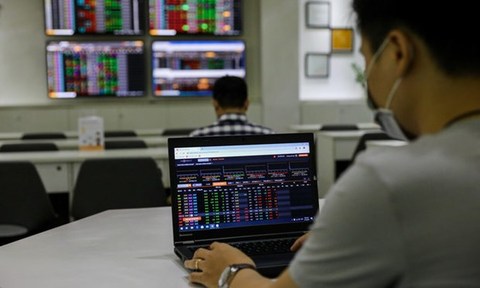 |
|
A man looking at a stock trading board on a laptop.
|
The Vietnamese stock market ended last month at 1,447.27 points, representing growth of 7.6 per cent compared to the beginning of October and 22.4 per cent for the year.
A report from VNDirect Securities Corporation said that cash flows continued to run into small-cap stocks in October, while divesting from large- and medium-cap stocks.
However, the securities firm expects that cash flows will return to large- and medium-cap stocks in November after the VN-Index hit new historical highs and formed short-term rallies.
Given good signs such as the reopening of the economy, the higher percentage of vaccinations and stimulus packages, the stock market’s outlook is expected to be positive.
Speaking during an online webinar launched by VNDirect earlier this month, Tran Khanh Hien, Research Director of VNDirect, said about three macro indicators that investors would need to pay attention to in the last two months of the year.
The first is the PMI index, which reflects whether enterprises’ production activities can return to pre-pandemic levels. The index will be described in profits in the next one to two quarters.
The second factor is the export index. In the context of disruptions in both input and output of global supply chains, the stronger export index means the country’s exports meet timely global demand.
Last but not least is the inflation indicator. Even though the inflation rate is low and stable, the risk remains, according to Hien.
Once inflation indicators show signs of moving higher, investors should be extremely careful in making investment decisions, she recommended.
The economy is also boosted by the Government's huge support packages, worth up to VND800 trillion (US$32.3 billion), or public investment policies, leading to bright prospects for the stock market, in general, and industry groups that directly benefit from them.
“Because we have just disbursed 50 per cent of the public investment plan, there is still room to boost for growth in the last few months”, Hien said.
In addition, the third-quarter business results so far have indicated more positive results than expected. As of November 1, the total net profit of listed companies that have announced last quarter’s financial statements increased by 21.5 per cent year-on-year. For the first nine months of 2021, net profit jumped 55 per cent.
The market’s focus is now shifting to the recovery in the fourth quarter and in the coming years.
VNDirect believed the market valuation would still be attractive with a long-term view, and it would continue to be supported by cash flow from retail investors amid low deposit interest rates.
Therefore, the firm expected the benchmark would be traded in a range of 1,380 - 1,480 points in November.
Stock groups to watch
As the economy is reopened with support policies from the Government, domestic consumption will rebound strongly in 2022. Hence, food and beverage businesses, retailers and air carriers will be the main beneficiaries.
Meanwhile, commodity prices are forecast to remain high next year due to strong consumer demand along with the recovery of the global economy. Accordingly, VNDirect assessed that oil and gas and commodity exporters would benefit from this development.
“As sea freight rates are expected to decline after being hit hard during social distancing, seafood exporters will be worth watching,” Hoang Anh Tuan, head of investment consulting at VNDirect, said at the webinar.
Infrastructure development is also in focus in the next few years as it is an important measure to promote economic growth, according to VNDirect. Besides road infrastructure, aviation and industrial zones, energy infrastructure will attract attention in the next two years.
For the long-term, investors should pay attention to the clean energy group, Hien said.
“It is not just current demand for developing cleaner energy, but environmental, social and governance (ESG) funds are looking for projects, companies related to cleaner energy and Viet Nam is a potential destination,” said Hien.
And although bank stocks fell 15 per cent from peaks, VNDirect said that the corrections partly reflected the existing downside risk, making the risk and investment efficiency in the banking sector more attractive.
Source: VNS